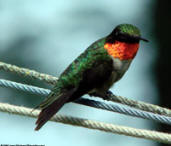|
Adaptations " Getting Along "
|
|
The Ruby-throated Hummingbird is a tiny creature in a big world, so adapting to its environment is crucial for it's survival. Below is a list of hummingbirds' adaptations and an explanation of how this advancement aids them in their daily life. Long, narrow bill and tongue
The slender shape of the beak allows them to feed on nectar located in deep
cupped flowers (their primary food source). Their tongue is abnormally
long and
lined with tiny hairs for quickly extracting nectar out of flowers. Flexible lower beak The lower bill, which widens and bends downward as the bird opens its mouth, allows them to "scoop" insects out of the air while in flight. Type I Muscle Fibers Ruby-throats are almost constantly in motion, and with an average wing speed of 50 beats/second, they need something to prevent them from tiring. Their pectoral muscles are composed of close to 100% of Type I muscle fibers. These reddish fibers utilize oxidative metabolism, so they are good for endurance and are slow to tire. Click here to read more about: Type I muscle fibers and oxidative metabolism Torpor When temperatures drop or food conditions are poor, hummingbirds can go into torpor. Torpor is a very deep sleep-like state in which metabolic functions are significantly slowed down and body temperature is very low. This act is sometimes necessary because feathers supply poor insulation and they have incredibly high metabolic demands, making maintaining such a high body temperature (~105 degrees F) and metabolic rate difficult.
|




